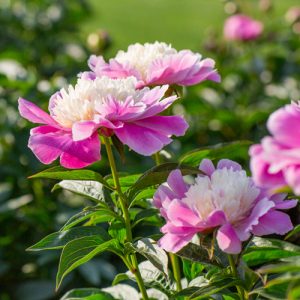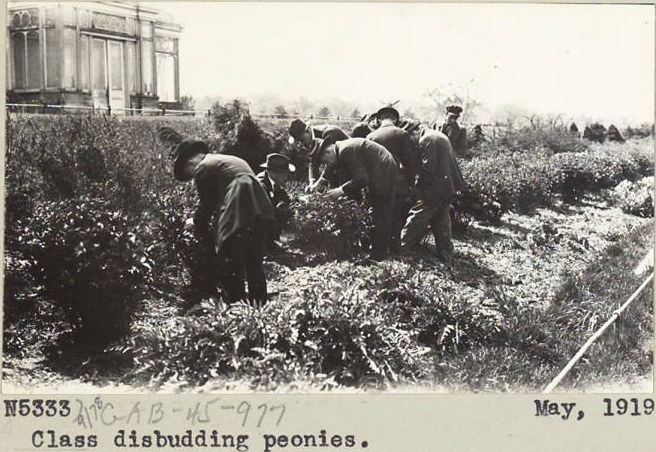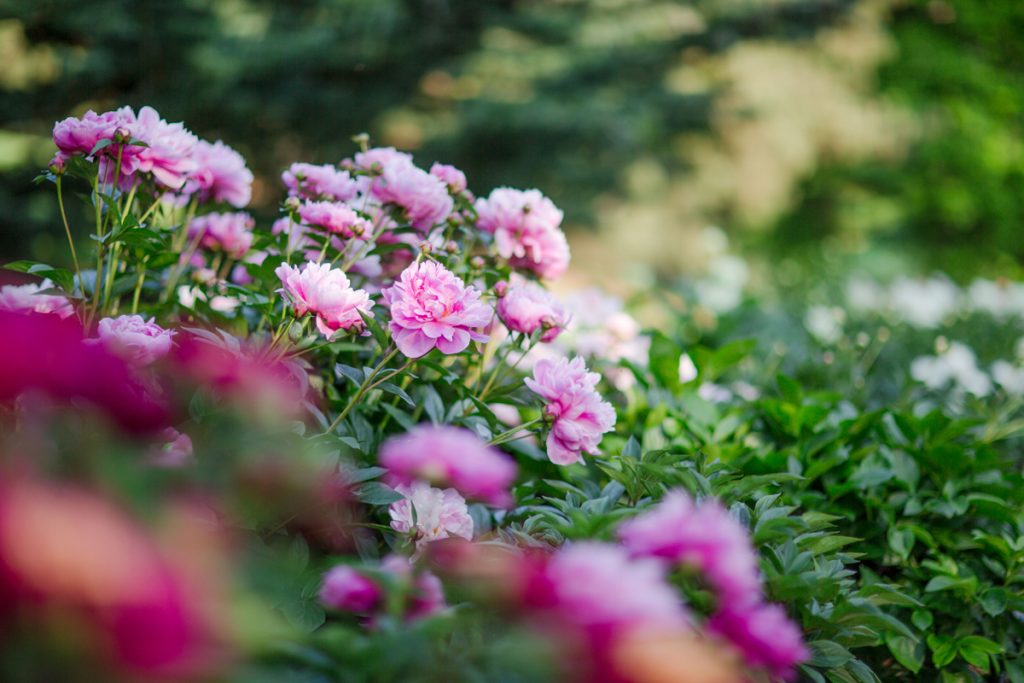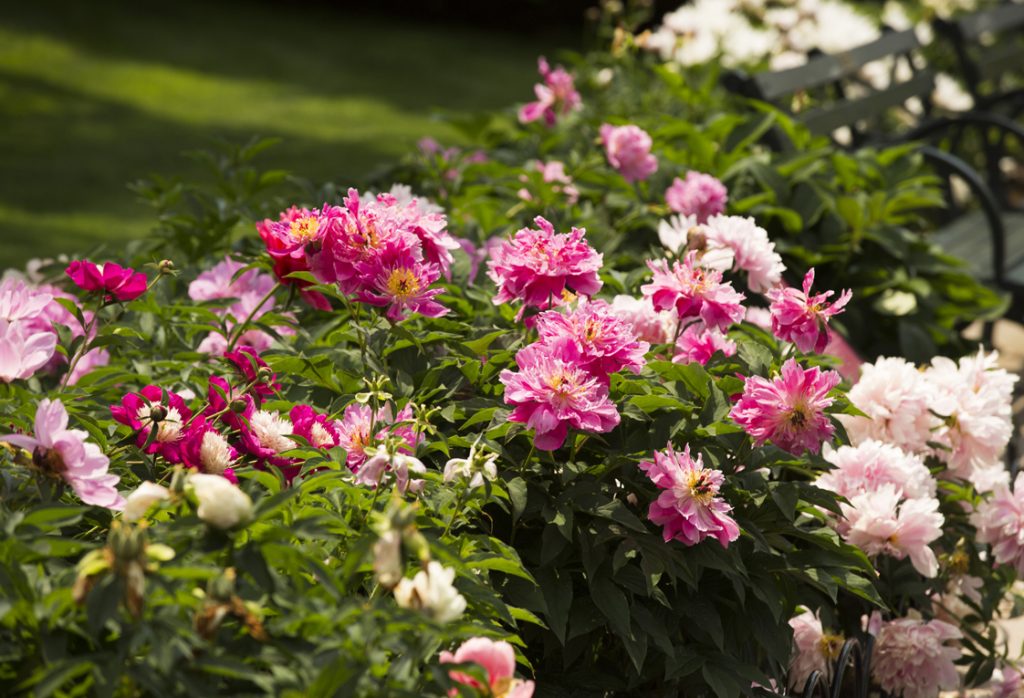On Peonies & Patience
Posted in Horticulture on June 22 2016, by Brian Sullivan
Brian Sullivan is the Vice President for Landscape, Gardens and Outdoor Collections. He oversees the care, presentation, and development of the outdoor gardens and landscape management of the Garden’s 250 outdoor acres.
 If you visit the Garden this summer and walk down Perennial Garden Way to the Enid A. Haupt Conservatory, you will find a tidy planting bed that runs parallel to the roadway, edged with a short iron wicket fence and filled with robust perennials. If you were lucky enough to find yourself walking here three to four weeks ago, around Memorial Day, you would have been immersed in the flowers of the newly renovated Matelich Anniversary Peony Collection.
If you visit the Garden this summer and walk down Perennial Garden Way to the Enid A. Haupt Conservatory, you will find a tidy planting bed that runs parallel to the roadway, edged with a short iron wicket fence and filled with robust perennials. If you were lucky enough to find yourself walking here three to four weeks ago, around Memorial Day, you would have been immersed in the flowers of the newly renovated Matelich Anniversary Peony Collection.
Now in its second growing season, this collection of herbaceous peonies, Paeonia lactiflora, showcases the fragrant pink, white, red, and coral blossoms of one of the most popular garden plants and cut flowers.
The tradition of growing herbaceous peonies near the Conservatory dates back to the early 1900s, when peonies were grown in double borders along pathways surrounding the elegant glasshouse.

Although the uniforms of the gardeners have changed over the last decade, the commitment to growing excellent peonies has not. The existing collection along Perennial Garden Way was renovated in Fall 2014 to expand the planting beds, strengthen the collection, and extend the bloom season.
The length of the bed was doubled to meet the adjacent pathways. The width of the bed also doubled, from three feet deep to six feet, allowing room to accommodate two rows of plants for a denser effect. Of the existing 75 plants, about 50 were lifted, divided, and returned to the renovated beds. More than 100 new peonies were added to represent the best new cultivars. With a focus on fragrance, stem strength, and bloom sequence, garden staff selected the best new plants from leading breeders.
The horticulture staff also paid a good deal of attention to improving the growing conditions in the planting beds. The beds were dug to 36” to improve the drainage and the soil was amended with NYBG’s own compost and soil mix, creating the open and well-draining conditions necessary to grow peonies well.

With summer here, the peony flowering season is done. However, if you were captivated by this spring’s flowers and want to try to grow herbaceous peonies in your garden, you are in luck, since there is still time to plan for a fall planting.
Peonies can be planted either as potted plants in spring or bare root tubers in fall. Fall is ideal since the soil is still warm and will encourage root development ahead of next spring’s growth. Tubers should be fleshy, firm, and clear of any visible rot. Use the same parameters as you would when selecting produce at the market: if you wouldn’t eat it, don’t buy it.
Tubers come with ‘eyes’ that appear as nodes—next season’s growth—which should be oriented up when planting. Set the eyes slightly lower than the soil level and space the tubers about two to three feet apart. This might seem too wide, but it will allow plants room to grow with good air circulation. Once the tubers are planted, water through fall and consider mulching for the first winter to add extra protection. You can remove this in spring.
Peonies are long-lived perennials that prefer full sun, air circulation, and excellent drainage. Although they will bloom in shade, they set many more flowers and are overall healthier in full sun. Selecting a location and preparing the soil to meet these conditions ensures a beautiful plant for a long time to come. When preparing the bed, add compost to the existing soil and mix well—this helps loosen the soil and provide fertility. You can also consider adding organic fertilizer, keeping the nitrogen low.

New growth appears in early spring or late winter, depending on the year. The new growth, which emerges red, is quite hardy and able to tolerate the drop in temperatures we can expect in spring. Peonies have full, heavy flowers and a deserved reputation for flopping once the flowers have opened, which leads us to peony rings. These circular rings with a grid of support in the center are used to keep the stems from flopping. I like to install the support low to the ground early in the season, before growth emerges, and lift the ring as the growth extends. This keeps the stems in the grid and avoids having a stem get caught and start to bend downward. Herbaceous peonies, unlike the woody-stemmed tree peony, die back fully in the dormant season. Foliage can be cut down at the end of the season. The peony ring can be lowered to the ground and left in place through winter as a marker for the dormant plant.
Selecting the best site and preparing the planting beds sets a good foundation for healthy plants. However, you should monitor your plants for disease. Early detection of wilting or collapsing branches allows you to remove these plant parts quickly and minimize spreading, as does cutting back plants at the end of the season. To learn more about combating disease in the garden, visit Cornell University’s home garden resource website.
Peonies get better with time, so have patience. Expect them to be small and have few flowers in their first year. They will be bigger and flower better in year two, and even bigger and more floriferous in year three and beyond for you to enjoy.


Wonderful writing and historic and beautiful photos make this One to Save!
Brian, Thank you so much!